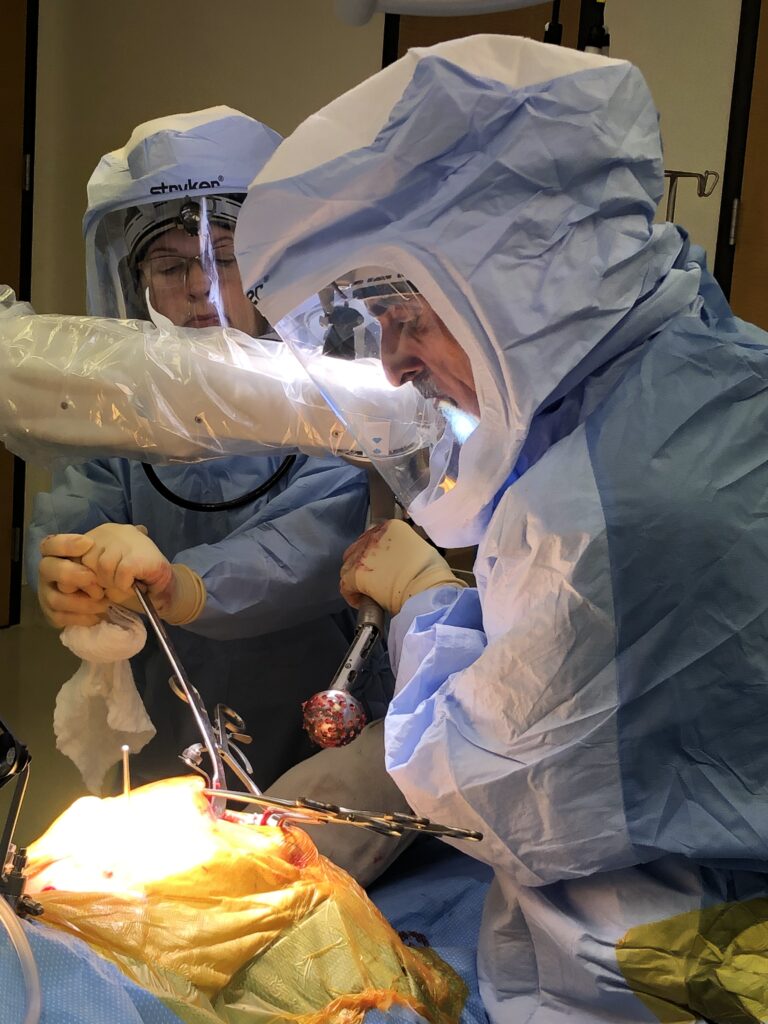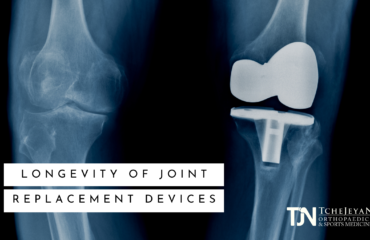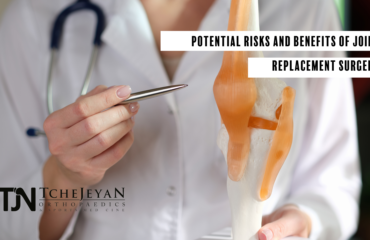For obvious reasons, infections are a complication surgeons always try to avoid. Infections are particularly inconvenient in orthopaedic joint replacement surgery. Ordinarily, in the unfortunate circumstance of infection, IV or oral antibiotics are administered to the patient, sending the antibiotics through the bloodstream to fight the infection. However, in joint replacement surgeries, the implanted device is made of metal. Blood doesn’t circulate on metal like it would through normal joints, which means the antibiotics may not reach the infection. Let us explain…
When a bacteria is growing on metal, it can form a film, called glycocalyx (which means “sugar coat”), which attaches to the metal. This film prevents antibiotics from reaching the infection. Consequently, the only way to heal these types of infections after joint replacement surgery is unfortunately with another surgery. This subsequent surgery would remove the implant, treat the patient with antibiotics, kill the infection, and then replace the joint with a new implant. Clearly, infections are, quite literally, a pain! That’s why good surgeons do everything they can to try and prevent infections.
Fortunately, board-certified orthopaedic surgeon, Dr. Gregory H. Tchejeyan, has an extremely low complication rate with infections. In fact, he’s ranked nationally as having one of the lowest infection rates associated with surgery!
This is because Dr. Tchejeyan takes many precautions to ensure that the facility, the team, and the patient are as sterile as possible before the surgery even begins. Here are 14 ways Dr. T. ensures the safety of his patients:
- Chlorhexidine Soap – Dr. T. sends patients home with the antibacterial chlorhexidine soap prior to surgery. The patient must wash their body for 5 days with this soap to lower the bacteria count on the skin’s surface, BEFORE the surgery, thereby reducing the chances of potential infection
- Betadine Prep – Prior to surgery in the operative room, the doctor preps the patient’s leg from top to bottom, with antibacterial betadine to minimize postoperative infections.
- Nasal Swabs – No, it’s not the Covid test! Actually, taking a nasal swab prior to surgery helps to identify which particular bacteria the patient carries. Everyone carries bacteria, but this tells the doctor which one the patient’s body colonizes. That way, the doctor knows and can use, an antibiotic that would be most successful against it.
- IV Antibiotics – IV antibiotics are given to each patient 1 hour before surgery, then again after surgery in 2 doses, 8 hours apart. This helps fight infections before they start!
- Surgical Hospitals – Outpatient surgical centers are generally cleaner environments than, say, a general hospital because they primarily see healthy people, minimizing the germs in the facility. This sterile environment reduces chances for infection as well.
- Specialized Room – In a surgical center, specialized operating rooms have systems that push air in the opposite direction of the surgery, called laminar flow, keeping extra bacteria away from the surgical site.

- PPE – During surgery, Dr. Tchejeyan wears a closed-air helmet system that prevents anything from getting into the surgical wound. While some studies say they can’t prove a link to infection rate reduction, it definitely doesn’t do any harm, so Dr. T. takes the extra precaution with each surgery he performs. (Plus, it makes him look like a pretty cool astronaut!)
- Dedicated Surgical Team – Using the same team has allowed Dr. Tchejeyan to have an orchestrated system to the surgical process. Everyone is prepped with the proper sequence and tools, which limits traffic and doors opening to retrieve tools – all things that could lead to infections. This also improves the surgery, making it more efficient and safer for the patient. Dr. T. has actually timed himself and he has his surgical steps down to a T – no pun intended!
- Antibiotic
–Impregnated Bonding Agent – The bonding agent that fixates the implant device to the skeleton is a type of cement or grout-type substance. Dr. T uses a special cement that is impregnated with antibiotics, allowing a high concentration of local antibiotics to reach the implant site. This provides a higher local dose of antibiotic than could be administered intravenously or orally. The antibiotic within the cement lasts about 6 weeks, which provides extra infection prevention protection during the critical early healing phase.
- Surgical Time – Generally, Dr. T. completes his joint replacement surgeries in one hour – start to finish! Longer surgeries mean more exposure to the environment, and therefore a higher chance for infection. Without being hasty, and with over 10,000 surgeries under his belt, Dr. T. has perfected his craft to be most efficient, helping to lower the infection rate for his patients.
- Hemostasis – Hemostasis prevents bleeding. Excessive blood after an operation allows bacteria to grow more easily, so Dr. T. uses specialized tools to prevent bleeding around the incision. He also gives tranexamic acid, helping to decrease surgical bleeding, which in turn reduces the collection of fluid in the knee afterward. Excess fluid and blood are the channels for bacteria growth, but Dr. T’s routine techniques counteract that.
- Surgical Technique – Dr. T. is very meticulous and delicate with surrounding soft tissue so they seal well after the operation – you guessed it – to prevent infection!
- Medicated Dressings – Infection-fighting ionic silver is impregnated into the special surgical dressing that Dr. Thcejeyan uses on the surgical wound. This is applied in the sterile environment of the OR. You can see through it to observe the wound, but this waterproof bandage remains on for about two weeks, thereby eliminating the chance of introducing bacteria to the wound when the dressing is opened.
- Send the Patient Home! – Performing joint replacement surgeries as an outpatient surgery (going home the same day, or even staying just one night) allows for less chance of infection. Just two decades ago, rehab facilities would hold patients longer after surgery, and these facilities would carry more infections since they saw both sick and well patients. Sending people home allows them to be in a much cleaner environment, and the evidence is strong that sending them home leaves less chance of infection as compared to an increased stay in a hospital or aftercare facility.
These 14 points are incredibly important parts of the sterile surgical process. When it comes to infection prevention, you can never be too careful. Each of these practices are worth the extra time and effort it takes to implement them.
Dr. Gregory H Tchejeyan values precision and efficiency, which is why he’s been ranked as a surgeon with one of the lowest infection rates in the nation. They don’t call him the “LA Knee Guy” for nothing! If you are experiencing joint pain, and think you may need a joint replacement surgery, reach out to Dr. Tchejeyan’s friendly staff! Schedule your consultation! You’ll be in good hands before, during, and after any surgery performed by Dr. T.




